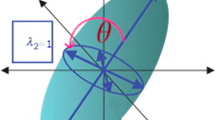Abstract
In signal and image processing, we want to recover a faithful representation of an original scene from blurred, noisy image data. This process can be transformed mathematically into solving a linear system with a blurring matrix. Particularly, the blurring matrix is determined from not only a point spread function (PSF), which defines how each pixel is blurred, but also boundary conditions (BCs), which specify our assumptions on the data outside the domain of consideration. In this paper, we first propose shifting reflective BCs which preserve the continuity at the boundaries and, therefore, reduce ringing effects in the restored image. A Kronecker product approximation of the corresponding blurring matrix is then provided, regardless of symmetry requirement of the PSF. Finally, we demonstrate the efficiency of our approximation in an SVD-based regularization method by several numerical examples.
Similar content being viewed by others
References
Jain A K. Fundamentals of Digital Image Processing. Englewood Cliffs: Prentice-Hall, 1989
Andrews H, Hunt B. Digital Image Testoration. Englewood Cliffs: Prentice-Hall, 1977
Kamm J, Nagy J G. Optimal Kronecker product approximation of block Toeplitz matrices. SIAM J Matrix Anal A, 2000, 22: 155–172
Levinson N. The Wiener RMS (root mean square) error criterion in filter design and prediction. J Math Phys, 1946, 25: 261–278
Kailath T, Sayed A H. Displacement structure: theory and applications. SIAM Rev, 1995, 37: 297–386
Ammar G S, Gragg W B. Superfast solution of real positive definite Toeplitz systems. SIAM J Matrix Anal A, 1988, 9: 61–76
Chan R H, Ng M K. Conjugate gradient methods for Toeplitz systems. SIAM Rev, 1996, 38: 427–482
Kalouptsidis N, Carayannis G, Manolakis D. Fast algorithms for block Toeplitz matrices with Toeplitz entries. Signal Process, 1984, 6: 77–81
Gonzalez R C, Woods R E. Digital Image Processing. Reading, MA: Addison-Wesley, 1992
Ng M K, Chan R H, Tang W C. A fast algorithm for deblurring models with Neumann boundary conditions. SIAM J Sci Comput, 1999, 21: 851–866
Nagy J G, Ng M K, Perrone L. Kronecker product approximations for image restoration with reflexive boundary conditions. SIAM J Matrix Anal A, 2004, 25: 829–841
Serra-Capizzano S. A note on antireflective boundary conditions and fast deblurring models. SIAM J Sci Comput, 2003, 25: 1307–1325
Perrone L. Kronecker product approximations for image restoration with anti-reflective boundary conditions. Numer Linear Algebra, 2006, 13: 1–22
Lagendijk R L, Biemond J. Iterative Identification and Restoration of Images. Dordrecht: Kluwer, 1991. 22
Nagy J G, Kilmer M E. Kronecker product approximation for preconditioning in three-dimensional imaging applications. IEEE Trans Image Process, 2006, 15: 604–613
Rezghi M, Hosseini S M. Lanczos based preconditioner for discrete ill-posed problems. Computing, 2010, 88: 79–96
Loan C V, Pitsianis N. Approximation with Kronecker products. In: Moonen M S, Golub G H, eds. Linear Algebra for Large Scale and Real Time Applications. Dordrecht: Kluwer, 1993. 293–314
Engl H W, Hanke M, Neubauer A. Regularization of Inverse Problems. Dordrecht: Kluwer, 1996
Hansen P C. Rank Deficient and Discrete Ill-Posed Problems: Numerical Aspects of Linear Inversion. Philadelphia: SIAM, 1997
Chung J, Nagy J G, O’Leary D P. A weighted-GCV method for Lanczos-Hybrid regularization. Electron Trans Numer Anal, 2010, 28: 149–167
Viloche Bazán F S, Borges L S. GKB-FP: an algorithm for large-scale discrete ill-posed problems. BIT, 2010, 50: 481–507
Dowski E R, Cathey W T. Extended depth of field through wavefront coding. Appl Optics, 1995, 34: 1859–1866
Björck A. Numerical Methods for Least Squares Problems. Philadelphia: SIAM, 1996
Vogel C R. Computational Methods for Inverse Problems. Philadelphia: SIAM, 2002
Hanke M. Conjugate Gradient Type Methods for Ill-Posed Problems. Harlow: Longman, 1995
O’Leary D P, Simmons J A. A bidiagonalization-regularization procedure for large scale discretizations of ill-posed problems. SIAM J Sci Stat Comput, 1981, 2: 474–489
Kilmer M E, O’Leary D P. Choosing regularization parameters in iterative methods for ill-posed problems. SIAM J Matrix Anal A, 2001, 22: 1204–1221
Kilmer M E, Hansen P C, Español M I. A projected-based approach to general form Tikhonov regularization. SIAM J Sci Comput, 2007, 29: 315–330
Jiang M F, Xia L, Shou G F, et al. Two hybrid regularization frameworks for solving the electrocardiography inverse problem. Phys Med Biol, 2008, 53: 5151–5164
Rudin L I, Osher S, Fatemi E. Nonlinear total variation based noise removal algorithms. Physica D, 1992, 60: 259–268
Paragios N, Chen Y, Faugeras O. Handbook of Mathematical Models in Computer Vision. New York: Springer, 2005
Nagy J G, Palmer K M, Perrone L. Iterative methods for image restoration: a Matlab object oriented approach. http://www.mathcs.emory.edu/~nagy/RestoreTools. 2002
Banham M R, Katsaggelos A K. Spatially adaptive wavelet-based multiscale image restoration. IEEE Trans Image Process, 1996, 5: 619–634
Neelamani R, Choi H, Baraniuk R. ForWaRD: Fourier-wavelet regularized deconvolution for ill-conditioned systems. IEEE Trans Signal Process, 2004, 52: 418–433
Wen Y W, Ng M K, Ching W K. Iterative algorithms based on decoupling of deblurring and denoising for image restoration. SIAM J Sci Comput, 2008, 30: 2655–2674
Author information
Authors and Affiliations
Corresponding author
Rights and permissions
About this article
Cite this article
Huang, J., Huang, T., Zhao, X. et al. Image restoration with shifting reflective boundary conditions. Sci. China Inf. Sci. 56, 1–15 (2013). https://doi.org/10.1007/s11432-011-4425-2
Received:
Accepted:
Published:
Issue Date:
DOI: https://doi.org/10.1007/s11432-011-4425-2




